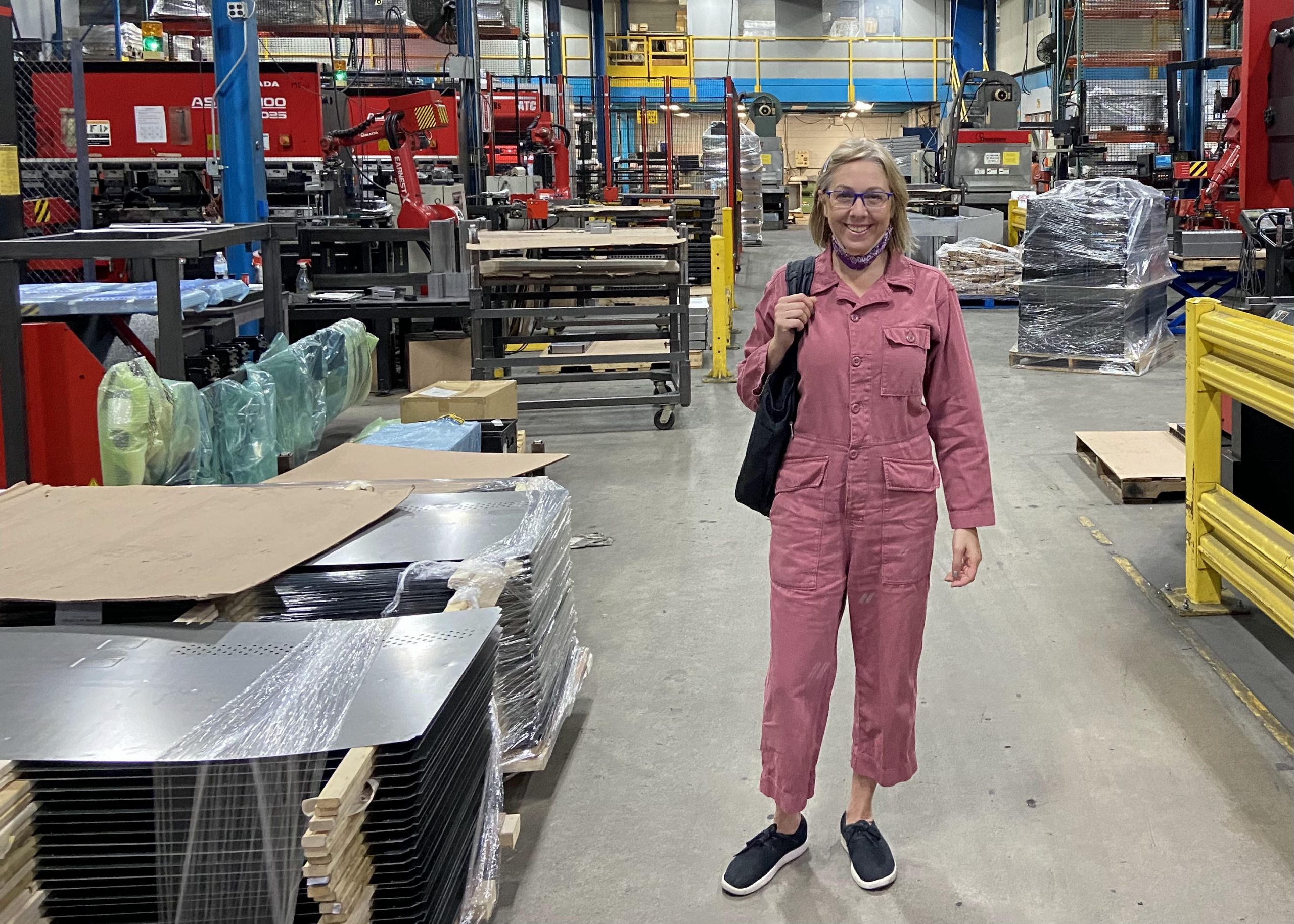My Dream is to Move My Manufacturing from China to Brooklyn

I left the factory tour and thought about how convenient it would be to walk or bike to the factory from my house, just a mile away. When I go to the factory in China, it’s a 7,300-mile flight, 15 hours each way.
By Liz Reisch Picarazzi
My search for a contract manufacturer in the U.S. kicked off in earnest in July, when my business was stuck in dozens of lines: in China, on the ocean, in the United States. Lines for bamboo, aluminum, labor, containers, ships, trucks, warehouses, customs and more. As I discussed in my last column, the clogged supply chain made me rethink manufacturing in China.
How does one shop for sheet metal fabricators? First, I Googled them. Way too many results, not organized by geography, or filterable. Then I consulted the granddaddy of industrial directories, ThomasNet, which has been around for 100 years and was originally published as a gigantic green book. I contacted 20 factories from ThomasNet, in New York, New Jersey, and Wisconsin, and requested quotes from 10 of them.
I chose New York and New Jersey for proximity. Why Wisconsin? I grew up in Madison and love to have reasons to go back. Also I noticed that Wisconsin dominates the Fabricator’s FAB 40 list, and has a high concentration of metal fabricators. And I presume that labor costs are lower in Wisconsin than in the Northeast, so that of course was a consideration.
After initiating the bidding process with the ThomasNet factories, it occurred to me that I had ruled out Brooklyn. I have searched here twice before, and the economics didn’t work. I assumed I couldn’t afford it because everything is expensive here. But maybe it was worth a shot.
Who could help? I needed a matchmaker, and I knew who to call. Mike DiMarino, who I’ve crossed paths with at SBIDC events over the years, has always struck me as the mayor of Brooklyn Industry, if that were a title. I called Mike, re-introduced myself, and said that I wanted to find a way to bring my manufacturing back from China to Brooklyn. He loved the idea, and immediately made some calls on my behalf.
Mike found a company that could not only do fabrication and painting, but also warehousing. Co-locating production with inventory storage is so efficient, and especially appealing in this supply chain nightmare. I thought about how great it would be for them to manufacture my product and also get rent, as a bundle.
Mike made the introduction and within days I went for a tour of the factory, which is a 10-minute walk from my house. The factory takes up what seemed like a whole city block on the Gowanus Canal, an area that has some remaining industry, amid lots of new restaurants and clubs. I was pleased to see that they have the latest metal-forming, stamping, and pressing machines, ideal for my aluminum trash enclosures and package lockers. I also liked that they have a strong reputation with designers and architects, which are a big part of Citibin’s client base.
While on the tour, a floor manager came to introduce himself, and jokingly said that Mike had called ahead to say that the “trash lady” would be there. That gesture meant a lot, and reinforced my image of Mike as a connector who picks up the phone old school and makes things happen. They were very complimentary of my product and asked to review the production drawings and visit nearby installations in order to do a quote.
I left the tour and thought about how convenient it would be to walk or bike to the factory from my house, just a mile away. When I go to the factory in China, it’s a 7,300-mile flight, 15 hours each way. I was thrilled with the possibility of my installers being able to load the van in Brooklyn instead of having to drive out to the warehouse an hour away in New Jersey multiple times a week, especially since tolls on the Verrazano Bridge have increased again.
In a moment of grandiosity, I may have imagined the headline “Brooklyn Businesses Team Up to Reshore Manufacturing From China.” I envisioned working together to create local jobs and high school apprenticeships, even collaborating on trash enclosures for the New York Department of Sanitation. My dream scenario was finding a factory that’s hyper-local and here to ease my supply-chain pain.
Was my head in the clouds? Unfortunately, yes. A few weeks after the wonderful tour, I received a quote that was almost double what I pay now in China, even with the savings on freight and tariffs. It was so far off that it wasn’t worth negotiating. I don’t say this critically but rather with the understanding that no business should take on unprofitable work. The cost of labor and commercial real estate is crazy high in Brooklyn relative to other places I’m considering. Their costs are their costs.
I can’t afford my dream factory, but I don’t regret Mike introducing us. Even though it didn’t work out with them now for mass production, I’m glad to have made the connection because we have custom work that is best done locally and some government contract opportunities that have to be Made in the USA. How great would it have been to have the Made in Brooklyn moniker? I tried.
Now it’s time to venture beyond NYC. There are already five fewer contenders, since some opted out because they didn’t have capacity or didn’t think they could compete with China. In the next column I’ll share how the factories in New York, New Jersey, and Wisconsin compare to those in Brooklyn and China. I’m determined to make this happen.
Liz Reisch Picarazzi, CEO of Citibin, writes regularly about her entrepreneurial journey.